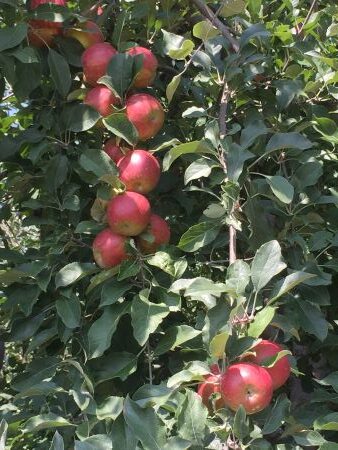How to Grow Apple Trees

About Growing Apple Trees in Your Yard
Apple trees have been around since the garden of Eden. Since the beginning of time, apples have been the most popular of all fruits. They are grown all over the world. The only place you won’t find this tasty fruit growing is at the North and South poles. So, it’s no surprise to see home gardeners growing apple trees in their yard or garden.
If you are space-limited or do not want to climb a ladder, you’re in luck, there are many dwarf varieties that will be perfect in smaller yards.
Did You Know? On average, apple orchards have 950 trees per acre and yield 1,100 bushels per acre.
Plant Hardiness Zones: 3 – 8.
Apple Tree Propagation
Apple trees are grown from seed. It takes several years to go from the seedling stage to an apple-producing tree. Most people let the garden nurseries start apple tree seedlings, and nurture them to a size that can be transplanted to your garden. Then, people buy small trees that are a couple of years old, from a garden store. When growing apples, plan ahead. If you buy a small tree, it will take about 3 years to get your first fruit.
Did You Know? Apple trees are members of the Rose family! More Apple Trivia
How to Grow Apple Trees
Select a location in your yard that receives full sun. Dig a deep hole. Add plenty of decomposed compost, if available. Mix thoroughly with regular garden soil. If the apple tree you bought is inside of a decomposable peat pot, leave it in the container. It is helpful, (but not required) to slit the container, to allow roots to more easily exit the container. While making the slits, be careful not to cut the roots, as you can do more harm than good. If your tree is in a burlap bag, remove the bag. Gently spread the roots in the hole you have dug.
Bury the roots of the plant up to where it was in the container. Soak the soil thoroughly. Add more soil, if needed. Once your new apple tree is planted, it should grow well with little or no attention. We do recommend staking the tree in its first year of life. Strong winds can bend the young sapling, causing the trunk to grow at an angle. Really strong winds might even cause the tree to sway and damage roots.
Years to first apples: 3-4
Tip: Fruit tree fertilizer spikes are a great way to boost the growth of your new tree. The spike slowly releases a fertilizer specifically formulated for fruit trees.
Once your apple tree is a few years old, it is important to prune the tree yearly. Pruning removes saplings and non-productive branches that only take energy from the tree, without producing fruit. It can also be used to keep top growth limited and make your bright, shiny apples more reachable at harvest time. More on Pruning
Ideal Soil pH: 5.5 – 6.5.
More on Insects and Disease
Apple Size
Do you want to Grow big apples? The size of the apples is dependent upon several things. Sometimes, mother nature pollinates a profusion of blooms. So many apples may be on the tree, that the fruits are numerous but small. Growers can compensate for this by removing a few of the baby apples very early in the season. Should you do this? Probably not in your first few years of growth, as you do not have the experience to judge if there are too many baby fruits on the tree. We do recommend removing any fruit that are damaged by insects, leaving good apples to grow big and sweet.
Did you Know? Apples are more efficient at waking you up than caffeine.
Insect, Pests and Plant Disease
Apple trees and their fruit, are very susceptible to insects and disease. If you want good apples, you are best advised to apply regular applications of fruit tree spray. We recommend an all-purpose insect and disease spray available at your local garden store. More on Insects and Disease
When using sprays we recommend you follow the directions on the label carefully. And by all means, wear protective clothing and a mask when spraying.
Deer, squirrels, and other pests enjoy apples, too. Pest netting and pest control are important.
Related Articles
Please support our site. Shop for:
- rmmatthews100@hotmail.com
- 585-721-6528
- Rochester, NY
©1999-2024 GardenersNet.Com, All Rights Reserved

